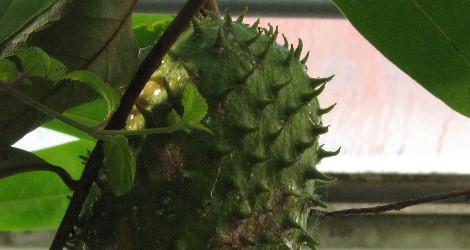Accession Data:
Annona muricata L.
sect. Annona
- Common Name: Soursop
- Family: Annonaceae Juss.
- Country of Origin: tropical America
- Description: A small, upright evergreen which cannot stand frost. It may be grown only in warmest parts of Florida or in greenhouses. The leaves are dark green and glossy. The fruit is 6-9", yellow green in color, with white flesh. The pulp is excellent for making drinks and sherbets and, though slightly sour-acid, can be eaten out-of-hand.
- Uses: Medicinal Main Actions (in order):
anticancerous, antitumorous, antimicrobial, antiparasitic, hypotensive (lowers blood pressure)
- Main Uses:
- for cancer (all types)
- as a broad-spectrum internal and external antimicrobial to treat bacterial and fungal infections
- for internal parasites and worms
- for high blood pressure
- for depression, stress, and nervous disorders
- Properties/Actions Documented by Research: antibacterial, anticancerous, anticonvulsant, antidepressant, antifungal, antimalarial, antimutagenic (cellular protector), antiparasitic, antispasmodic, antitumorous, cardiodepressant, emetic (causes vomiting), hypotensive (lowers blood pressure), insecticidal, sedative, uterine stimulant, vasodilator
- Other Properties/Actions Documented by Traditional Use: antiviral, cardiotonic (tones, balances, strengthens the heart), decongestant, digestive stimulant, febrifuge (reduces fever), tonic">nervine (balances/calms nerves), pediculicide (kills lice), vermifuge (expels worms)
- Cautions: It has cardiodepressant, vasodilator, and hypotensive (lowers blood pressure) actions. Large dosages can cause nausea and vomiting. Avoid combining with ATP-enhancers like CoQ10.
- Useful part: Leaves, Fruit, Root, Bark, Seed.
- Medicinal Info from Rainforest Tropical Plant Database http://rainforest-database.com/plants/graviola.htm Leslie Talyor 2005 - DEAD LINK Feb 2016.
- IMPORTANT NOTE: Plant Uses are for informational purposes only. EEB Greenhouses assume no responsibility for adverse effects from the use of any plants referred to on this site. Always seek advice from a professional before using any plant medicinally.
- Main Uses:
- USDA Zone: 10b-11
Accession Data:
- Accession # 199900586
- Source: Maugeri ex CRFG
- Accession Date: 10-05-1999
- Bench: 1311 - NEOA: Ground Bed 1 SE
- Currently: active - healthy
- Qty: 2 confirmed on 01-09-2025
Classification:
- Division: Magnoliophyta
- Class: Magnoliopsida
- SubClass: magnoliids
- Order: Magnoliales
- SubOrder:
- Family: Annonaceae
- SubFamily: Annonoideae
- Tribe: Annoneae
- SubTribe:
Flowering Data:
This accession has been observed in bloom on:| Year | Jan | Feb | Mar | Apr | May | Jun | Jul | Aug | Sep | Oct | Nov | Dec | ||||||||||||||||||||||||||||||||||||||||
|---|---|---|---|---|---|---|---|---|---|---|---|---|---|---|---|---|---|---|---|---|---|---|---|---|---|---|---|---|---|---|---|---|---|---|---|---|---|---|---|---|---|---|---|---|---|---|---|---|---|---|---|---|
| 2025 | ||||||||||||||||||||||||||||||||||||||||||||||||||||
| 2024 | ||||||||||||||||||||||||||||||||||||||||||||||||||||
| 2023 | ||||||||||||||||||||||||||||||||||||||||||||||||||||
| 2022 | ||||||||||||||||||||||||||||||||||||||||||||||||||||
| 2021 | ||||||||||||||||||||||||||||||||||||||||||||||||||||
| 2020 | ||||||||||||||||||||||||||||||||||||||||||||||||||||
| 2019 | ||||||||||||||||||||||||||||||||||||||||||||||||||||
| 2018 | ||||||||||||||||||||||||||||||||||||||||||||||||||||
| 2017 | ||||||||||||||||||||||||||||||||||||||||||||||||||||
| 2016 | ||||||||||||||||||||||||||||||||||||||||||||||||||||
| 2015 | ||||||||||||||||||||||||||||||||||||||||||||||||||||
| 2014 | ||||||||||||||||||||||||||||||||||||||||||||||||||||
| 2013 | ||||||||||||||||||||||||||||||||||||||||||||||||||||
| 2012 | ||||||||||||||||||||||||||||||||||||||||||||||||||||
| 2011 | ||||||||||||||||||||||||||||||||||||||||||||||||||||
| 2010 | ||||||||||||||||||||||||||||||||||||||||||||||||||||
| 2009 | ||||||||||||||||||||||||||||||||||||||||||||||||||||
References (internal):
- Medicinal Plants - Ayurveda Medicine
- Medicinal Plants
- Basal Angiosperms (paleodicots)
- Beetle Pollination (cantharophily)
- Beverage Plants
- Edible Plants
- Plants with Edible Fruits
- Type Species
- EEB 3271 - Systematic Botany
- Medicinal Plants - Musculoskeletal System
- Medicinal Plants - Respiratory System
- Medicinal Plants - Immune System
- Medicinal Plants - Traditional African Medicine
References (external):
- Morton, J. 1987. Soursop. p. 75–80. In: Fruits of warm climates. Julia F. Morton, Miami, FL. Last accessed on Thursday, February 04, 2016.
- CRFG Website. Last accessed on Thursday, February 04, 2016.
- Annona muricata at Wikipedia. Last accessed on Thursday, February 04, 2016.
- The Plant List (2013). Version 1.1. Last accessed on Thursday, February 04, 2016.
data regenerated on Thu, 09 Jan 2025 12:00:13 -0500 [bcm v4.0]
Images:

Additional images for this accession:
Click on thumbnails to enlargeCurrent Accessions in the Annonaceae
Subfamily Annonoideae
Tribe Annoneae
Subfamily Annonoideae
Tribe Xylopieae
W/C = Wild Collected
 = indicates flowering in past 14 days
= indicates flowering in past 14 days
 = images available for this accession
= images available for this accession
 = map available for this accession
= map available for this accession
 = accession added within past 90 days
= accession added within past 90 days

